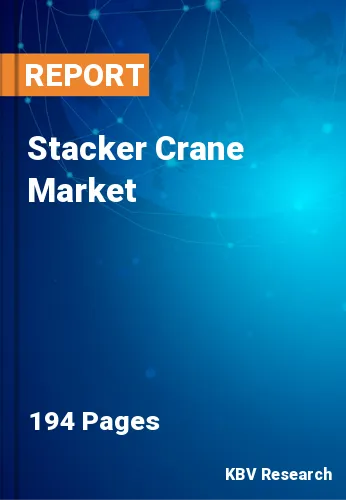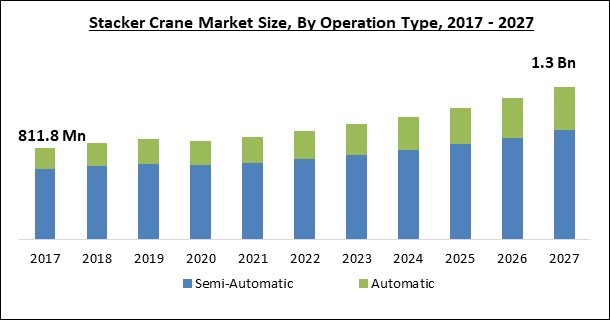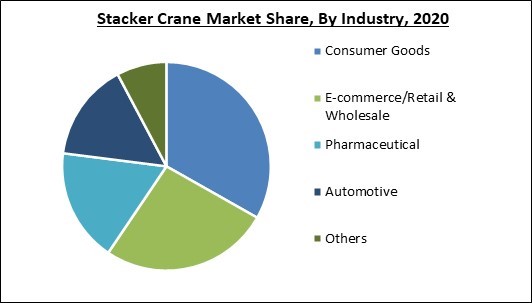
The Global Stacker Crane Market size is expected to reach $1.3 billion by 2027, rising at a market growth of 6.9% CAGR during the forecast period.
A stacker is a material handling machine that comes in a range of shapes and sizes and uses hydraulic and electric technology. Shop floors, factories, warehouses, transportation hubs, manufacturing, and logistics all require material handling machines. Additionally, stackers are also constructed with a variety of lifting capacities for material handling in construction, worksites, and maintenance applications.
Compact material handling equipment has gained popularity in recent years due to its ease of maintenance, portability, and comparable performance to big machinery. Moreover, unlike heavy machinery, small material handling equipment, such as stackers, does not require qualified personnel and is much easier to use. Additionally, the demand for stacker machines among end-users is also boosted by their cheaper costs as compared to other traditional material handling equipment.
Using a stacker crane system, ASRS lowers the requirement for human intervention in common operations including accurate storage of an item at a current location, retrieval of an item, and delivering commodities to particular processing or interface areas. As a result, ASRS deployment saves money on labor and maximizes space. Additionally, increasing warehouse rents and dwindling warehouse availability are expected to boost the use of ASRS systems and the use of stacker cranes.
Some of the growth catalysts for the stacker crane market are increasing product complexity, a growing need for smart logistics, a good return on investment, greater space use, and increased consumerism via online platforms. Moreover, technological advancements and developments in stackers provide market participants profitable growth opportunities. On the other hand, the rising deployment of forklifts would act as a barrier to industry growth.
The stacker crane is useful in a variety of situations. Another notable application is for a steel foundry, where enormous designs and fixtures are stored and retrieved. This customer, to whom the product was offered, manufactures mining equipment valves, hydraulic casings, and castings. The patterns and fixtures are used to make these products in batch quantities.

The spread of COVID-19 is likely to increase demand for e-commerce shopping, leading merchants to invest in automation solutions to meet the increased demand. Automation solutions are expected to be used by companies attempting to defend themselves from supply chain interruptions in the future. As a result, the rising need for automated storage and retrieval solutions from the e-commerce, retail, healthcare, and food & beverage industries is driving the expansion of the stacker crane market.
Lockdowns imposed in many countries, on the other hand, have caused serious cash flow problems for market players. The manufacturing curve for semiconductors and electronics declined during the pandemic. Moreover, the machinery business is shrinking but is likely to level off in the coming years.
Stacker cranes are an important part of the ASRS system. Basic actions like exact storage of an item at a preset place, retrieval of an item, and transporting items to specific processing or interface points are all made possible by ASRS. Thus, the deployment of ASRS lowers labor costs and increases space utilization. The use of ASRS systems is projected to be driven by rising warehouse rents and decreasing warehouse availability. The e-commerce business is booming as a result of the exceptional increase in the number of online customers following the COVID-19 pandemic. Consumers have turned to internet purchasing as a result of the implementation of social distancing rules, lockdowns, and other measures in response to the COVID-19 epidemic. This has resulted in a surge in both business-to-consumer (B2C) and business-to-business (B2B) e-commerce.
Emerging economies such as India, Brazil, Mexico, and China have experienced rapid industrial expansion as a result of globalization. This has motivated global manufacturers to establish manufacturing plants in these countries. Due to different economic advantages, various businesses such as food and beverage, pharmaceuticals, retail, and automotive are focusing on expanding in rising economies. The increased demand for these products is putting pressure on their distribution and logistics networks. As a result, demand for automated warehouses is rising throughout various industries, resulting in a surge in stacker crane demand. As a result, as industrial growth accelerates, more efficient and automated manufacturing and distribution procedures would be adopted.
A Stacker crane works in tandem with a number of sensors, motors, and other pieces of equipment, all of which are controlled by software. In addition, any technical difficulty with the stacker crane's sensing element might cause an entire operational process to be halted, causing the company to lose time and money. Moreover, any flaw in the software programming might cause the stacker crane to malfunction, causing the entire production process to be delayed and increasing downtime that can last anywhere from a few minutes to several days. As a result, system failures have a negative impact on the process, resulting in lower earnings.

Based on Type, the market is segmented into Single Column and Double Column. The Double Column procured a significant revenue share of the Stacker Crane Market in 2020. In retail and wholesale industries, double-column stackers can assist in overcoming the constraints of limited aisles and cramped stockrooms. Moreover, they are ideal for handling pallets, transporting them, replenishing shelves, and unloading double-deck lorries in busy areas.
Based on Operation, the market is segmented into Semi-Automatic and Automatic. In 2020, the Semi-Automatic segment acquired the largest revenue share of the Stacker Crane Market. This is because of the growing demand for semi-automatic machines in warehouses and enterprises where manual or human intervention is required. Moreover, many enterprises have increased their investment in procuring these machines to drive their operational efficiency.
Based on Industry, the market is segmented into Consumer Goods, E-commerce/Retail & Wholesale, Pharmaceutical, Automotive and Others. The E-commerce/Retail & Wholesale segment acquired a significant revenue share of the Stacker Crane Market in 2020. This is because the market for stacker cranes is mostly reliant on storage facilities dedicated to wholesale supplies, which serve as the foundation for massive retail supply all over the world.
| Report Attribute | Details |
|---|---|
| Market size value in 2020 | USD 875.2 Million |
| Market size forecast in 2027 | USD 1.3 Billion |
| Base Year | 2020 |
| Historical Period | 2017 to 2019 |
| Forecast Period | 2021 to 2027 |
| Revenue Growth Rate | CAGR of 6.9% from 2021 to 2027 |
| Number of Pages | 194 |
| Number of Tables | 350 |
| Report coverage | Market Trends, Revenue Estimation and Forecast, Segmentation Analysis, Regional and Country Breakdown, Companies Strategic Developments, Company Profiling |
| Segments covered | Type, Operation Type, Industry, Region |
| Country scope | US, Canada, Mexico, Germany, UK, France, Russia, Spain, Italy, China, Japan, India, South Korea, Singapore, Malaysia, Brazil, Argentina, UAE, Saudi Arabia, South Africa, Nigeria |
| Growth Drivers |
|
| Restraints |
|
Based on Regions, the market is segmented into North America, Europe, Asia Pacific, and Latin America, Middle East & Africa. In 2020, APAC emerged as the leading region in the overall Stacker Crane Market. This is because to rising usage of these cranes in China and India. Moreover, other nations in the area, like Japan and South Korea, are expected to increase their market share by upgrading and retrofitting existing stacker crane systems. In addition, global stacker crane manufacturers are relocating to the region. As a result of the technology transfer, the number of local players has increased, which is predicted to lower the cost of stacker crane adaption in the region.
Free Valuable Insights: Global Stacker Crane Market size to reach USD 1.3 Billion by 2027
The market research report covers the analysis of key stake holders of the market. Key companies profiled in the report include Toyota Industries Corporation, SSI Schaefer Group, Daifuku Co., Limited, Kion Group, Knapp AG, Kuka AG, Hyster-Yale Materials Handling, Inc., Jungheinrich AG, Mitsubishi Logisnext Co., Ltd., and Murata Machinery Ltd.
By Type
By Operation
By Industry
By Geography
The stacker crane market size is projected to reach USD 1.3 billion by 2027.
Massive industrial development in developing nations are driving the market in coming years, however, technical difficulties with sensor elements limited the growth of the market.
Toyota Industries Corporation, SSI Schaefer Group, Daifuku Co., Limited, Kion Group, Knapp AG, Kuka AG, Hyster-Yale Materials Handling, Inc., Jungheinrich AG, Mitsubishi Logisnext Co., Ltd., and Murata Machinery Ltd.
Yes, COVID-19 is likely to increase demand for e-commerce shopping, leading merchants to invest in automation solutions to meet the increased demand.
The Single Column segment has acquired maximum revenue share in the Global Stacker Crane Market by Type in 2020, thereby, achieving a market value of $875.1 million by 2027.
The Asia Pacific is the fastest growing region in the Global Stacker Crane Market by Region in 2020.
Our team of dedicated experts can provide you with attractive expansion opportunities for your business.
